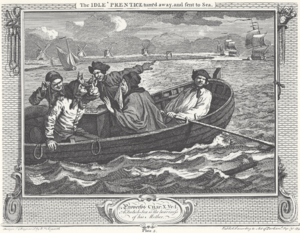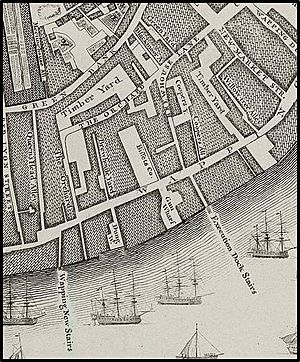Execution Dock facts for kids
Execution Dock was a special place on the River Thames in Wapping, London. For over 400 years, it was used to carry out punishments for pirates, smugglers, and mutineers who had been found guilty by special courts called Admiralty courts. The "dock" was actually a platform where hangings took place. The very last punishments at Execution Dock happened in 1830.
Contents
History of Execution Dock
The British Admiralty was like a special court system. It had the power to deal with all crimes that happened at sea. Execution Dock was built right by the river, just past where the water goes out at low tide. This showed that the court's power reached even into the water.
Anyone who committed crimes on the ocean, whether close to home or far away, would be brought to London. There, a special court called the High Court of the Admiralty would decide their fate.
The Journey to the Dock
People who were to be punished at the dock usually came from Marshalsea Prison. Some also came from Newgate Prison. The journey to Execution Dock was a public event. The people being punished were paraded across London Bridge and past the Tower of London.
A high-ranking official, the High Court Marshal, led the procession on horseback. He carried a silver oar. This oar was a symbol of the Admiralty court's power. The prisoners rode in a cart to Wapping. A chaplain rode with them, encouraging them to think about their actions.
Just like other public punishments, the condemned were allowed to stop at a pub on the way. There, they could have a drink before reaching the gallows.
Public Spectacle and Customs
When a punishment happened at the dock, large crowds would gather. People would line the riverbanks or even rent boats to get a better view. The hangings were carried out by the same people who worked at other famous punishment sites like Tyburn or Newgate Prison.
There was a specific custom for those found guilty of piracy. The hanging was done with a shortened rope. This meant the process was slower. People sometimes called this the Marshal's dance because of how the bodies would move.
Unlike hangings on land, the bodies of pirates at Execution Dock were not taken down right away. It was a custom to leave the bodies hanging until at least three tides had washed over their heads. This practice ended in the late 1700s.
Famous Cases and Last Punishments
An old magazine called The Gentleman's Magazine described a typical punishment at Execution Dock in 1796.
The well-known Captain Kidd was found guilty of piracy and murder. He was brought from Newgate Prison and punished at the dock in 1701. During his punishment, the rope broke, and it had to be done a second time. After his death, his body was displayed by the River Thames at Tilbury for three years.
The very last hangings at Execution Dock happened on December 16, 1830. George Davis and William Watts were punished for piracy related to the Cyprus mutiny.
Location of the Dock
Some historical records suggest that a large "E" on the Thames side of the building at Swan Wharf marked the spot of Execution Dock. Other sources say it was roughly where the Wapping train station stands today.



